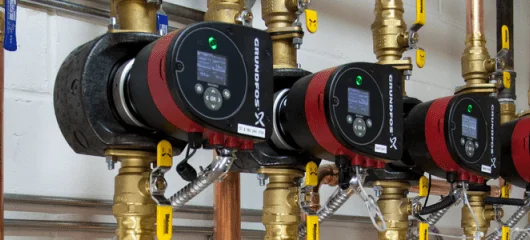Fall-off pressure is the reduction of pressure at the outlet of a pressure reducing valve (PRV), when downstream fixtures are open to allow flow through the PRV. If, for example, a PRV is set at 70 psi, that is the static pressure setting and represents the PRV downstream pressure in a no-flow condition. As soon as fixtures start to open, water begins to flow through the PRV and the downstream pressure will fall. More open fixtures means more flow through the PRV, resulting in more fall-off pressure. The amount of fall-off pressure depends on the inlet pressure of the PRV, the size and design of the PRV and the flow rate through the valve (sum of all fixtures).
Fall-off pressure is an important consideration when sizing a PRV for a given application. A PRV that is undersized might have too much fall-off which will result in insufficient pressure at the fixtures and unhappy water users! Be sure to consider the fall-off pressure through the valve, and piping losses all the way to the farthest fixtures.
Most PRV manufacturers' literature have some type of chart or graphs showing fall-off pressure for their valves; some are hard to understand. Caleffi's 535H Series PRV literature makes sizing and selection very simple. Take a look at Technical Brochure 01265/16 NA; Graph 1 tells you at a glance which size valve to pick based on pipe velocity between 3 and 6 feet/second (recommended velocity). Graph 2 tells you what your fall-off pressure is based on the GPM flowing through the PRV.
Our Coffee with Caleffi webinar from July 2016, Applying Pressure Reducing Valves in Plumbing Systems featuring guest speaker Julius Ballanco, P.E., is all about PRVs; feel free to take a look at the webinar archive at your convenience.
We look forward to your comments, post one below, and contact us if you have any questions!







A municipality’s public water system could be operating at a large range of pressures:
• The system could be operating at a high pressure and the building PRV is reducing the pressure of the water delivered throughout a building to the requirements dictated by the code.
• The system could also be operating at a low pressure, where the PRV is not performing it’s function. In this scenario, there is still a friction pressure loss experienced on the system that needs to be accounted for in the overall system design. This is what I’m most concerned about.
Scenario:
I've got a city main operating between a range of 57 psi and 93 psi. A PRV will need to be installed at the building to ensure the pressure in the distribution system doesn't exceed 80 psi. I'm looking for guidance on how to determine the pressure drop associated with the PRV when the pressure from the city main is at the low end of the range (anything below 80 psi). The system demand is 35 gpm.
Thank you in advance!
In reply to A municipality’s public water by Justin Stirling
Justin
There is a chart available with the pressure drop information available along with sizing information in the tech brochure. This information can be found on the North American website. In this case A pair of PRV's piped in parallel and set to the appropriate pressures will allow delivery of water to the building during high and low pressure periods.
I have recently purchased an old rambling house with "Working" underfloor heating. However there must be a small leak (or two) in the system that is physically impossible for me to track down. It must be a small leak and equates to around 1 Bar of water pressure loss a week. A quick gentle top up (2-3 seconds) and all is good for another week. Would any Caleffi valve address this problem? I would like to automatically keep the downstream pressure at around 1-2 Bar without trekking down to the basement to top up every week. Thanks.
Peter, yes we have a device called AutoFill that connects to your water supply and will automatically maintain your system pressure. Search our website for 573 AutoFill Combo for information.
My city water provider's line pressure is between 50-100+ psi. With a pressure gauge connected in-line, up-stream and down-stream of my pressure regulator valve, under static no-flow conditions, both gauges read up stream pressure. Under flow conditions, the down stream gauge reads PRV set pressure and the up-stream gauge reads city line pressure. Please suggest possible cause and correct action for this condition.
Thanks you,
M.Blum
Hi Marc,
It sounds like your PRV may have debris/deposits in the seat area, allowing pressure to leak through the valve. Suggest disassembly, inspection of the internals. Dirt in PRVs, allowing pressure leak, is the #1 "failure" mode.
Do all PRV valves also act like a check valve or backflow preventer?
In reply to Do all PRV valves also act by Farrukh Imtiaz
A PRV will only provide pressure control and only work properly when installed in correct direction of flow. The valve bodies are marked with an arrow to indicate flow direction. They do not have a check valve or act lke a backflow preventer that is why you will usually see a backflow preventer installed before the PRV. Backflow preventers are a requirement in a hydronic system.
My static water pressure is between 50-70 psi. I have a piece of equipment that I want to hook up and it states that 90 psi static is maximum and 15-50 psi dynamic. Would I need a PRV?
Greg, Your static pressure is within the working limits of the equipment you are looking to connect to it. You would need to varify your dynamic water pressure to see if that falls with in the design working pressures of you the equipment you are looking to connect. If the dynamic pressure is above the specified 50 psi you would need to add a PRV.
I just installed a new PRV that I purchased from Home Depot to replace a failing one. I've noticed that after a few hours of no one running any water the pressure meter I installed on the hose faucet reads 120psi. Why would this be happening?
In reply to I just installed a new PRV by Tom M
Tom, two reasons you may see downstream pressure increase. One you may have debris from installation in the seat of the valve body allowing pressure creep. Even a small copper piece in the seat can cause it to over pressurize the system. Second you may have thermal expansion. When water is heated it can expand and increase pressure in the system. A system expansion tank may be needed to absorb the thermal expansion.
I have an extremely odd issue relating to PRVs. I have to have a PRV due to an unvented cylinder setup. The incoming main is 8.5 bar so kind of high. All PRVs I've used have been rated for 16 bar input.
But they keep failing!! The failure mode is extreme vibration - enough to be felt opposite side of the house and a noise that can be heard down the street.
I've tried 5 PRVs now from two different companies. The PRV is on a 22mm pipe.
What can cause a PRV to make such a noise/vibration?
Changing output pressure or input flow makes no difference.
In reply to I have an extremely odd issue by Rich
RIch, The incoming pressure is within specifications. When we see noise and vibration, it usually does not relate to incoming pressure or pressure reduction. It has to do with flow rate through the valve. We recommend selecting the valve size by calculating design flow rate and referring to the flow characteristic chart in the technical brochure. Then selecting the model that will provide that flow rate at a 3-6 f/s velocity. Then referring to the minimum flow rate that valve can work at a 1 f/s velocity. It is not uncommon to see the valves sized on pipe size and the flow rate of that pipe size connection is oversized for the actual building requirement. You could see a PRV that is one or two pipe sizes then the connecting piping because of flow requirements. An over sized PRV will cause vibration and noise.